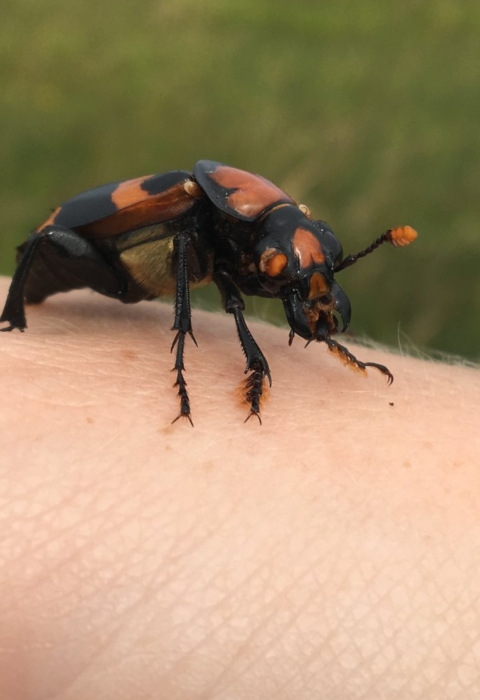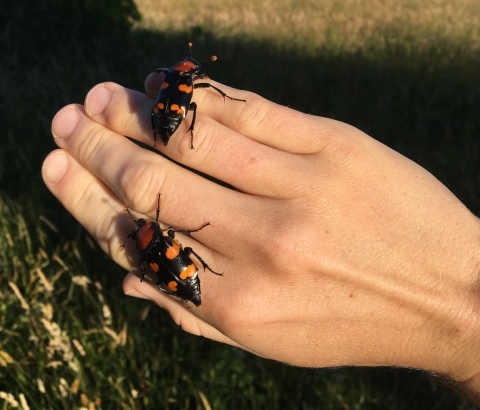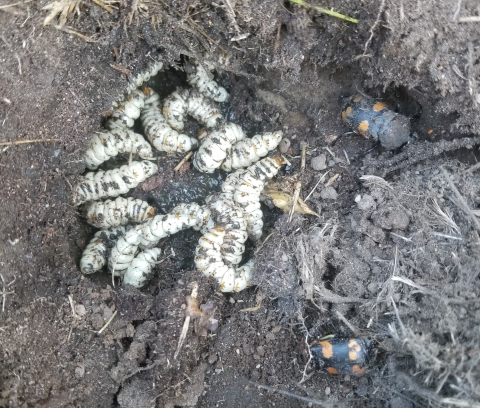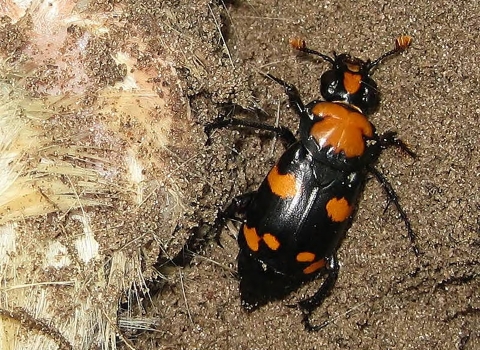It’s the perfect weather to bury a body.
On a clear morning in late June, when the salty, sweet air is still cool, a field crew arrives with shovels in hand at a grassy field on Block Island, just off the coast of Rhode Island.
They dig rows of holes, about a foot in diameter, and one crew member brings out the bodies, laying a dead quail to rest in each grave. Close behind them, teammates rush to place two large beetles — a female and a male — into every hole and cover it all with a still-intact, grassy top.
But this isn’t a somber burial; it’s a celebration — for the American burying beetle, that is.
The Nature Conservancy’s team will return in a couple weeks to check on their beetle matches and see if they were successful. Hopefully, they’ll find the beetle pairs caring for newly hatched larvae underground.
This project is part of the American burying beetle recovery program that has been in action on Block Island since the early ‘90s.
When the beetle was listed as endangered under the Endangered Species Act in 1989, the community on Block Island was just one of two known populations left in the entire United States.
“So that’s a very special population,” said Cindy Corsair, U.S. Fish and Wildlife biologist at the Southern New England Coastal Program. As the Northeast region’s species lead for the American burying beetle, she coordinates the New England recovery plan, which includes the Block Island population, as well as an introduced population on Nantucket, a captive breeding program and research.
With many moving pieces, partnerships play a key role in making sure the beetle persists.
Partnering up
American burying beetles are like something straight out of a campy Halloween thriller. Noticeable due to their size, about 1-1.5 inches in length, their black bodies are covered in orange-red markings and feature large antennae with bright orange tips.
The beetles bury and feed off carrion — dead animal carcasses — a crucial component of their reproductive cycle. After initially fighting a group of beetles over the dead body, a pair of male and female “winners” rely on teamwork to move the carcass to their preferred burial grounds: Lying on their backs, they use their legs to shuffle the body along, like a crowd surfer. Once in soft dirt, they dig under and around the animal, covering it with soil and putting it to rest below the surface.
It’s labor intensive, and sometimes the carrion can be stolen by another animal, but that’s where the field crew’s quail provisioning comes into play.
"That gives them a little bit of a boost. It's a head start to their reproductive cycle so they don't have to go out and search, find a mate and find a piece of carrion," Corsair said.
Once buried, the beetles go to work preserving the body using their own secretions, which prevent mold and bacteria from growing — essentially embalming it. The female lays her eggs next to the carcass and, once they hatch, both parents feed the larvae by first consuming then regurgitating tissue from the dead body.
As gruesome as it may sound, this ritual plays an important role in the ecosystem. By eating and digesting carrion, the beetles speed up the decomposition process, returning nutrients to the surrounding soil quickly. They also help control fly populations, simply by burying the dead — no bodies for the flies to breed on.
A beetle in distress
American burying beetles used to fly through forests and grasslands in 35 states, but in the 1920s, humans noticed a severe drop in the number of beetle communities, which became even more alarmingly low by the 1960s.
One of the root causes of the beetles’ decline is likely due to fewer carrion available to support reproduction. The ideal carcass for American burying beetles weighs 50 – 200 grams, about the size of a pigeon, rat or shrew — small enough for them to move and bury but large enough to feed the beetle larvae as they grow. Unfortunately, animals (and thus dead animals) of this size have experienced declines in their own populations. There’s a close correlation between the disappearance of the passenger pigeon, which was hunted to extinction by the early 1900s, and the decline of the American burying beetle.
“There’s the theory that the passenger pigeon was their primary resource, right in their niche and the right size for them. It’s possible they were specialized to them,” Corsair said.
Watching the dominos fall, it’s natural to wonder which species might be impacted if the American burying beetle were to go extinct.
Fortunately, the Endangered Species Act has provided the beetle with formal protection and support since it was listed as endangered. Under the act, we've monitored, managed and supported the Block Island beetle community and prioritized efforts to reintroduce populations into their historical habitats, like on Nantucket Island in Massachusetts. This is all done with the essential support of our partners.
Implementing a successful recovery program
On Block Island, Scott Comings has worked with the American burying beetle for 27 years, now as associate state director for The Nature Conservancy.
Every summer, his team counts and monitors the beetle population. Typically, they estimate between 750 to 1,000 beetles each year.
“If you look at the population over time, you’ll see that it’s a very consistent line,” said Comings. “It’s right where it should be, and I think that speaks to doing the right management.”
While The Nature Conservancy actively manages the Rhode Island American burying beetle population, the Roger Williams Park Zoo is leading the charge on Nantucket, while also hosting the breeding program.
The zoo’s American burying beetle breeding project was developed in partnership with the U.S. Fish and Wildlife Service in the early 1990s.
“When the U.S. Fish and Wildlife Service approached the zoo to ask if we wanted to rear American burying beetle, we said: ‘Yes! This is amazing.’ We knew invertebrate conservation was going to be the future,” said Lou Perrotti, director of conservation programs for the zoo. He's championed the American burying beetle’s recovery for more than 25 years.
Since its inception, the program has successfully raised more than 5,000 beetles, and over 3,000 of them have been released on Nantucket — part of the species’ historical range.
Searching for answers
Research is another important piece of the recovery puzzle. Still working to understand this mysterious creature, scientists hope to answer outstanding questions to improve management practices. For example, what type of carrion is ideal for the beetles now?
A researcher at Purdue University is conducting a post-doctoral study to uncover incredible insights into each individual beetle’s life history using stable isotope analysis, which takes literally the idea that “you are what you eat.”
From a clip of a beetle’s elytra, the hard wing cover on its back, we can determine what type of carrion, down to the species, it was fed in the larval stage. This tells us if the beetles prefer a certain species and how much they’re relying on the carrion we’re providing, compared to what they’re finding on their own.
For the population on Nantucket, this information will be especially valuable. They're not yet self-sustaining and rely heavily on the breeding and provisioning programs.
"I think the stable isotope research will help us narrow down exactly why that is and what species we need to manage for on the islands to make sure that they have the resources that they need," Corsair said.
After all, it’s all connected.
Downlisted
In October 2020, after more than 30 years of the recovery program, we downlisted the American burying beetle from endangered to threatened. Although the species has been lost from much of its historical range, additional communities were discovered in Nebraska, South Dakota, Kansas and Arkansas after it was listed as endangered. While this beetle may no longer have an immediate risk of extinction, it remains threatened with extinction and continues to receive protection and support under the Endangered Species Act.
One major threat to the beetle isn’t unique to the species: climate change climate change
Climate change includes both global warming driven by human-induced emissions of greenhouse gases and the resulting large-scale shifts in weather patterns. Though there have been previous periods of climatic change, since the mid-20th century humans have had an unprecedented impact on Earth's climate system and caused change on a global scale.
Learn more about climate change . The Species Status Assessment determined that climate change may negatively impact the species and that, in high-emissions projections, only the New England populations will persist beyond 2070.
This underscores the importance of our continued work on Block Island and Nantucket.
“This is sort of the epicenter of the world for the species,” Comings said. “It's one of the few areas that the beetle occurs where climate change won't be an issue.”
The beetles in New England can also provide insight into best practices for relocating communities north in the future.
Celebrating teamwork
In its 50th year, the Endangered Species Act is estimated to have saved 99% of the species listed. Every species is part of the web of life, each with a unique culture and biological community, performing services that are essential to our mutual well-being. By conserving them, we help ensure the benefits that accrue from them — healthy air, land and water — on which we depend.
Beyond the known natural benefits of the American burying beetle are the ones still unknown. Scientists are fascinated by the beetles’ abilities to preserve carrion with their bodily fluids and curious to learn if it could lead towards meat preservation techniques or future antibiotic treatments. If we lose these beetles, or any other species, we might lose our own future advancements.
Fortunately, recovery programs aren’t slowing down. From managing the breeding program to carrying out the monitoring and provisioning and even opening their lands to this field work, partners do much of the heavy lifting. Much like American burying beetles carry an animal carcass in pairs, we’re fortunate to carry this conservation effort together with dedicated partners.
And with this strong team in place, we hope to find American burying beetles in New England well into the future.
Or, as Scott Comings says, when it comes to extinction: “Not on my watch!”










